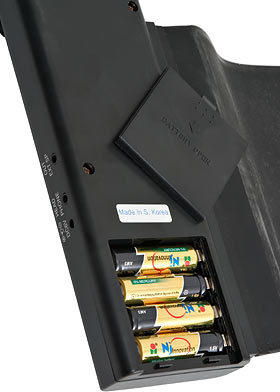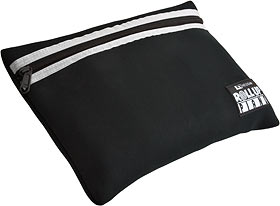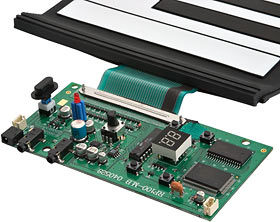
Hecsan Rollup Piano
Review date: 8 October 2004.Last modified 03-Dec-2011.
The keyboardist's life is not a happy one.
Not only is that "You'd like to learn to play, my dear? Come sit here between my legs on the piano stool, then, and we'll begin!" gambit not nearly as effective as we were promised, but our instruments are also a pain to move around.
Some keyboard instruments can, of course, only be moved by major geological upheavals. Then there are acoustic pianos; moving them is at least possible, but it's a famously major exercise even when you're not dealing with an Ultimate Behemoth. Significant compensation is usually involved.
Electronic keyboards make things a great deal easier, of course. They bring the portability of the piano accordion to civilised people. One person can tote around even a big 88-note weighted controller keyboard, if they have to.
Tiny, though, keyboards still ain't. Even if all you want is a miserable four octaves of full-sized keys (not that toy keyboards and, uh, things get no love from me, but only an elf can play proper chords on them), you're already talking something about 70cm long (27.5 inches). It's practically impossible to make a full-sized-key keyboard less than about 25cm deep (10 inches), and it's going to have to have some thickness, too, to accommodate the key mechanism.
Now, lots of people manage to tote acoustic guitars around, and they're typically around a metre long before you put 'em in a case. But it's not as if you can stick one in your funky little backpack.
This, you can. It's called the Rollup Piano.
I was alerted to its existence under the Yamano brand, but the people who sent me one to play with are Hecsan Incorporated who, y'know, have a Web site in English, and everything.
The Hecsan Rollup Piano looks like exactly the same product as an earlier model Yamano, but the only difference is the electronics module on the end. That looks a bit funkier on the newer Yamano but, as we'll see, it probably doesn't matter very much. The big deal about these things is the keyboard.
It's made of rubber.
It can do this.
The thing has the consistency of a rather thin automotive floor mat. All it lacks is a tiny Tom Hanks to dance around on it.
And yet, you can play it. On your lap, in a pinch, though that'll restrict you to playing Chopsticks. You really need a hard, flat surface to rest the keyboard on. A desk or coffee table works fine. Carpet is barely acceptable. Grass ain't a great idea.
It's OK if you don't quite have enough space for all four of the keyboard's capacious octaves; you just won't be able to play the keys that flop off the end of your airline tray table, or whatever. If any keys are actually flopping around as your camel (or what-have-you) gallops, those notes may occasionally sound of their own accord. The keys are reasonably resistant to nuisance triggering, though; if you roll the keyboard up while the Piano's turned on, not as many random notes sound as you'd expect.
The flat keys use a simple, and I think decently durable, rubber membrane design.
There's a depression around the edge of each key, so you can feel where you are without looking, but that's about all the ergonomic joy you're going to get out of this thing. There's almost no "click" when you press a key, and they of course barely move at all under your fingers.
The contact area is large, though; you can get a note when you press right up to the edges of all of the keys, and all of their length works, too, except for the very last half-inch or so. Your fingers shouldn't be going there anyway.
This sort of keyboard is not, actually, new. Membrane buttons of one kind or another feature on umpteen household appliances, of course, but they've also been used on some previous classic musical instruments. Those membrane 'boards are all mini hunt-and-peck synth controllers, though, kin to plastic button 'boards and certain cult toys. Full sized membrane keyboards are a definite rarity. There's the Rollup Piano, and I suppose that cardboard piano qualifies as well, but that's about it, as far as I know.
Details
The Rollup Piano's electronics module is a simple little thing - power button, volume knob, two digit LED display, one small speaker, and four buttons. The buttons let you scroll through the 99 (!) sounds, toggle a not-very-noticeable vibrato effect, and reset the Piano to its power-up state.
The Piano runs from four humble AA batteries, which are included, and it doesn't work 'em too hard; it's supposed to last at least 12 hours from a set of alkalines.
It has an input for a six volt AC adapter (also included, but you're meant to remove the batteries while you use it...), and outputs for headphones and an external speaker. These outputs are every bit as monophonic as the built-in speaker, but at least the headphone output gives you mono sound in both ears, not just one.
That's it for the Rollup Piano's features. No velocity sensitivity (different loudness depending on how hard you hit the keys), no aftertouch (modulation based on how hard you press they keys after hitting them), no bender lever, no pedals.
What, you were expecting MIDI?
The bottom line
Hecsan sell the Rollup Piano for $US149.95, plus shipping. For that price, you get the keyboard itself, four AAs, an AC adapter...
...and this neat-o zip-up case.
Bagged up, with batteries, ready to go, the Piano's about 28 by 20 by 8cm in size, (11 by 8 by 3 inches), and weighs about 900 grams (two pounds).
This is, of course, way smaller and lighter than any "proper" keyboard with full-sized keys, and substantially smaller and lighter than any reduced-size toy keyboard.
If size and weight don't matter that much to you, then the Rollup Piano will have no appeal at all. Hit the flea markets and you can find new keyboards from less than totally famous brands that give you five velocity sensitive octaves, stereo speakers, a solid set of sounds and various other features for, oh, $US125, tops.
But those keyboards take up about ten times as much luggage space as the Rollup Piano, and weigh an easy six times as much. The only regular keyboards that come anywhere near the Rollup Piano in size and weight are those little tiny controller 'boards with no sounds of their own, for use with separate synths and sequencers.
Playing it
If you're thinking that playing a flat rubber "piano" won't be quite as pleasantly sensual an experience as tickling the ivories of a Steinway, or a Casiotone organ for that matter, you're right. The Rollup Piano feels almost as bad as that laser projector keyboard that never seems to make it to market; there's pretty much zero tactile feedback, and the thin rubber provides little cushioning for your fingers. Play one of these things eight hours a day and I suspect you'll be crippled inside a week. After an hour of noodling and recording demo clips with the Rollup Piano set up on my computer desk, my wrists were pretty much shot.
And the rubber surface leaves a lot to be desired, too, compared with the smooth finish of ordinary keys. A lot of piano techniques depend on being able to slide your finger from one key to another, which is very difficult when the keys are made of grabby rubber. I managed to slicken the Rollup Piano up a bit with a spritz of silicone spray, but a joy to caress it still was not.
Startlingly enough, though, it is pretty playable, if you set your standards low enough. It's inescapably sloppier than a proper keyboard, with keys occasionally not sounding or intermittently pinging away when you're trying to hold a chord, but it really could suck a great deal more than it does. Here's an MP3 example, using the default acoustic piano instrument number 1; you can hear the last chord going intermittent, but the rest of the notes pretty much behaved themselves, and I didn't have to do twelve takes to make one that sounded OK.
All of the examples that follow are, similarly, take one or two; mistakes in them are about 50% the Piano's fault and about 50% mine.
The sound selection is pretty low-fi, but could be worse. Here's that piano again. A lot of the sounds are eminently forgettable, but as usual for cheapo keyboards, a few could cut it in a bigger mix. There's tolerable synth bass, a couple of passable pads, a pair of piddly pipe organs that desperately need reverb; you get the idea.
The fact that the black keys on this keyboard are no taller than the white ones, incidentally, also makes one new trick possible. You can glissando not just up and down all of the white notes, but up and down all of the notes (MP3). I'm sure there are other Stupid Floppy Keyboard Tricks waiting for some busker to discover them.
Inside
The manual (PDF) tells you not to disassemble the Rollup Piano.
Oops.
The two chips nearest the camera in the above picture are an AdMOS Technology (now owned by LG Semiconductor) QS1000, and its companion QS1001A. A lot of PC users have heard these chips before; they provide the basic "Wavetable" instruments that graced a lot of old sound cards, right back to the days when you had to buy a daughterboard to get 'em, and then discover that games didn't use 'em.
Overall
There are worse keyboards than this in the world. Much worse. The young people of today may not believe me, but I remember playing music into Aegis Sonix on an Amiga 500 QWERTY keyboard, before the Trackers were a glint in the milkman's eye. A small corner of my brain remains dedicated to the memory that Q equals C and Z equals low C.
But there are, of course, much better keyboards than this out there, too, and you don't have to pay any more to get them.
The Rollup Piano is a dancing bear; the wonder is not how gracefully it dances, but that it dances at all. A four-octave full-sized keyboard (of sorts) that you can fit into a skinny briefcase is something of an achievement, and there really are people in the world who have a good use for one of these, or at least want one. I don't need one, but I'm still going to enjoy whipping it out from time to time.
If the extreme portability of the Rollup Piano doesn't matter to you (and if you're not living in a coffin hotel, or something), then you definitely shouldn't buy one. And if you need a keyboard as portable as the Rollup Piano and intend to play it a lot, then I think it's still a pretty bad idea. This thing's ergonomics are not good, so I think you'd do better to resign yourself to having to lug around something bigger, rather than turn your hands into claws. Try waiting for a collapsible keyboard using different technology.
Even if you take all of its limitations into account, though, the Rollup Piano is not just the party-trick gadget it seems to be at first.
If you want to be able to rattle off a four-octave tune on a piano that genuinely will fit into a tiny backpack, this is the product for you.
Review Rollup Piano kindly provided by Hecsan Incorporated.








